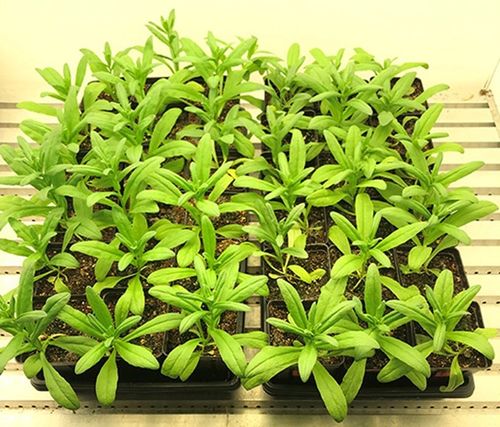K-State biochemists make significant breakthrough in increasing purity of specialized plant oils

Using synthetic biology techniques, K-State biochemists have made significant breakthroughs in cultivating camelina and pennycress. / SOURCE: K-State
December 23, 2024
BY Kansas State University
Some of the more commonly known and grown oilseed crops in the U.S. have long been canola, soybeans and sunflowers, but a breakthrough by Kansas State University biochemists could lead to the cover crops pennycress and camelina also becoming a source for improved biodiesel.
A research team led by Timothy Durrett, professor of biochemistry and molecular biophysics, and doctoral conferee Linah Alkotami used synthetic biology techniques to significantly increase the amount of acetyl-triacylglycerols — a unique type of oil found and adapted from the burning bush plant — in pennycress and camelina to near-pure levels.
These acetyl-triacylglycerols, or acetyl-TAGs, are very useful for their low viscosity and performance in cold temperatures — a key criterion for use as diesel replacement.
The team published its results in the prestigious, peer-reviewed Proceedings of the National Academy of Sciences.
"When we make biodiesel, we take regular vegetable oil and convert it into biodiesel using a chemical process," Durrett said. "The idea is that with these acetyl TAGs is that the oil could be directly used as the fuel without any further chemical process needed. In this way, farmers could capture the chemistry involved in making biodiesel, as well as the profits involved. If you can grow your own fuel, that's a way of increasing energy independence."
Oil seed engineering has long been a difficult field, Durrett said. Throughout the plant kingdom, there have been various unusual but useful lipids that biochemists have been successful at finding and identifying the enzymes that create them. The overwhelming challenge has been determining how to adapt these enzymes to yield similar and pure enough oils in other plants.
Durrett's research team made its breakthrough by increasing one of the substrates used to synthesize the acetyl-TAGs in camelina and pennycress, reaching levels of 93% and 98%, respectively — significantly higher than the approximately 50% levels common at the start of Durrett's career.
"These levels are actually higher than the burning bush plant where we first identified this lipid, so to get to this level of purity is quite an achievement," Durrett said.
The next step for Durrett's research team is to continue studying these modified camelina and pennycress plants to determine what other changes are occurring.
"Anytime we make these changes in a seed, what we realize is that the plant 'fights back' against those changes, and we're still working to understand how plants are responding to these changes, and how we can control that," Durrett said. "Even though we're at 98%, there are still a lot of questions we're working to answer."
Farmers are particularly interested in these developments, as pennycress possesses a remarkable ability to overwinter, allowing farmers to plant these cash crops in late fall and harvest in early spring. Currently, the pair of plants are predominantly grown in the northern U.S., where much of the research into the plants started, but Durrett envisions the crops spreading to more of the country as agricultural producers learn how to commercialize them.
As part of a separate but related partnership, Durrett is working with Umut Yucel, associate professor of food science, to explore potential uses for the plants' oils in the food industry, as well as generally as an emulsifier and lubricant.
Other K-State students involved in the research include Dexter White, graduate student in biochemistry, and Kathleen Schuler, undergraduate in biology.
The research team's work was supported by grants from the U.S. Department of Agriculture's National Institute of Food and Agriculture and the U.S. Department of Energy's Office of Biological & Environmental Research.
Advertisement
Advertisement
Advertisement
Advertisement
Related Stories
U.S. fuel ethanol capacity fell slightly in April, while biodiesel and renewable diesel capacity held steady, according to data released by the U.S. EIA on June 30. Feedstock consumption was down when compared to the previous month.
The U.S. EPA on July 8 hosted virtual public hearing to gather input on the agency’s recently released proposed rule to set 2026 and 2027 RFS RVOs. Members of the biofuel industry were among those to offer testimony during the event.
The USDA’s Risk Management Agency is implementing multiple changes to the Camelina pilot insurance program for the 2026 and succeeding crop years. The changes will expand coverage options and provide greater flexibility for producers.
The USDA’s National Agricultural Statistics Service on June 30 released its annual Acreage report, estimating that 83.4 million acres of soybeans have been planted in the U.S. this year, down 4% when compared to 2024.
SAF Magazine and the Commercial Aviation Alternative Fuels Initiative announced the preliminary agenda for the North American SAF Conference and Expo, being held Sept. 22-24 at the Minneapolis Convention Center in Minneapolis, Minnesota.
Upcoming Events










